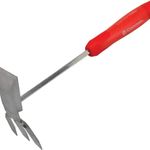
Sounds like horse poop directly from the source, right? I promise it isn’t. These two terms have only slightly different meanings and can work for you in several ways. When someone is planting a “green manure” they’re planting a crop in a garden bed while the usual vegetables are on hiatus. Green manure is a specific crop that’s sown in the beds and then turned under while they’re still green. They add nutrients (predominately nitrogen) back into the soil that the previous crop have used up; increasing the soil’s fertility for the next season’s vegetables.
When a cover crop is planted often the first thought here is to control erosion during the winter months, to provide weed control, as well as to enrich the soil. That said, both types of plants can perform all of these tasks – although some work better for one thing or another. In fact, both terms are very often used interchangeably.
Soils in garden beds get depleted of the nitrogen and organic matter needed to grow successful crops during the next planting season. This is especially true for crops such as corn – which is are very heavy feeders. I don’t want to discourage you from planting a fall garden, but if you’d like to give a garden bed (or two) a rest, this fall is the perfect time to plant a cover crop.
Once your summer crops are harvested, you can literally plant nutritional goods back into the garden bed and improve the soil. When you plant green manures in the fall, they act as a cover crop and keep your soil in the bed where you want it. It also smothers and crowds out early spring weeds. My perception of cover crops and green manures is that they’re right in line with compost bins, vermicomposting, grasscycling, and even mulch – they’re all a form of composting. In other words, they’re all about turning natural resources back into nature. This can never be anything but a good thing – don’t let anyone tell ya different.
Green manures usually fall into two categories; legumes and everything else – which is usually a grain-type. Grains like winter rye, rape, wheat, and oats basically work as cover crops for erosion control and your basic weed suppression. Also when they break down they add organic matter to the soil. All good stuff. The legumes are the ones that’ll give your soil the nitrogen boost. These would be fava beans, peas, alfalfa, vetch, and crimson clover. Mustard is often grown as a green manure due to it’s protective properties against nematode and verticillium wilt.
The idea here is to choose whatever cover crop strikes your fancy. You may have perfectly wonderful reasons for your cover crop choice; it’s the right one for the season, it provides cover quickly, it produces an uber amount of nitrogen, or it reminds you of the first time you got to first base – whatever. So you have your seed-of-choice and you broadcast those pups all over the bed. If you were thinking ahead, you’ll be sowing the seeds on a rainy day, but I digress.
Let these bad boys grow all winter and in the early spring about 3-4 weeks before you’re going to put your veggies in the garden, till these guys under. When I say “till” I’m not talking about renting some awkward machine, I’m talking about getting out there with a shovel and turn that stuff under the soil. If you can get a male-type to turm it under, that would free you up for creating Mojitos – just sayin. When the legumes die, they release a great amount of nitrogen which is like a triple-shot latte for your veggies.
Speaking of good things, the other thing to love about this technique is that it’s cheap-o. You’ll want to allow like 4 months for this process to see it’s way through. No cheating or it won’t work the way you’d like and you’ll be all over the editors at Vegetable Gardener.com about the hack they hired to write about gardening brilliance.
One last thing. There are going to be some gardeners freaking out because I dared to mention turning the soil in the early spring when it might be *gasp* really wet. Well, it’s true. We gardeners are persnickity about touching our sweet soil while it’s not yet workable or “wet” because it can mess with the tilth and all that. The only thing you can do is try to turn it under on a day where the soil is pretty darn close to workable, but not so late that you’re house is being taken over by 4 foot veggie seedlings just chomping at the peat pot to get into the ground.
Life’s a gamble. That’s all I got.
Fine Gardening Recommended Products

Greenworks 40V 14" Chainsaw, 2.5Ah USB Battery and Charger Included
Fine Gardening receives a commission for items purchased through links on this site, including Amazon Associates and other affiliate advertising programs.

Greenworks 40V (185 MPH / 340 CFM / 75+ Compatible Tools) Cordless Brushless Leaf Blower / Vacuum, 4.0Ah Battery and Charger Included
Fine Gardening receives a commission for items purchased through links on this site, including Amazon Associates and other affiliate advertising programs.

Fine Gardening receives a commission for items purchased through links on this site, including Amazon Associates and other affiliate advertising programs.





















Comments
Log in or create an account to post a comment.
Sign up Log in